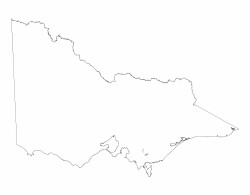3.1.3 Basalt residuals (Thorpdale, Nerrim South)
3. Southern Uplands (SU)
3.1 High relief, (moderate elevation, about 250 - 600 m) Otway, Strzelecki and Hoddle Ranges
| These areas represent residuals of the extensive Older Basalt flows that occurred during the Palaeogene. At Thorpedale, the basalt residual is continuous and covers an area of about 200 square kilometres. It forms a broad plateau with a landform which may be described as rolling low hills with shallow valleys that become deeper towards the plateau margins. While most of the basalt directly overlies the Cretaceous sediments, parts overlie Palaeogene fluvial sediments known geologically as the Childers Formation. Around Blackwarry and Carrajung the basalt residuals are discontinuous may be regarded as plateau remnants overlying the underlying Cretaceous sediments. In all three areas the annual rainfall exceeds 1 000 mm. In the Thorpdale area drainage is predominantly integrated and eventually runs into the Narracan Creek. At Blackwarry and Carrajung the basalts form a weak drainage divide and the major streams flowing north are Traralgon, Flynn’s and Merriman’s Creeks. Southerly flowing streams are Bruthen Creek and Tarra River. At Nerrim South, the drainage is to the south into the Tarago River. Originally the soils supported both Damp and Wet Forests with some Shrubby Foothill Forest. All of the soils developed on basalts are deep red friable gradational soils (Ferrosols) and almost all have been cleared for intensive agriculture. Landslips are common on slopes exceeding 10 degrees and are particularly common on moderate slopes below the basalt cap where the Childers Formation is exposed. Examples of such landslips occur on the valley slopes adjoining the upper part of Narracan Creek. |  |


